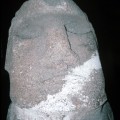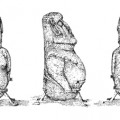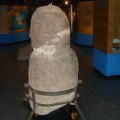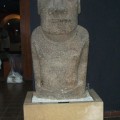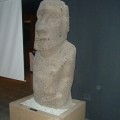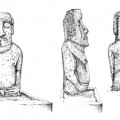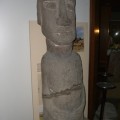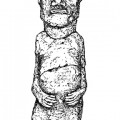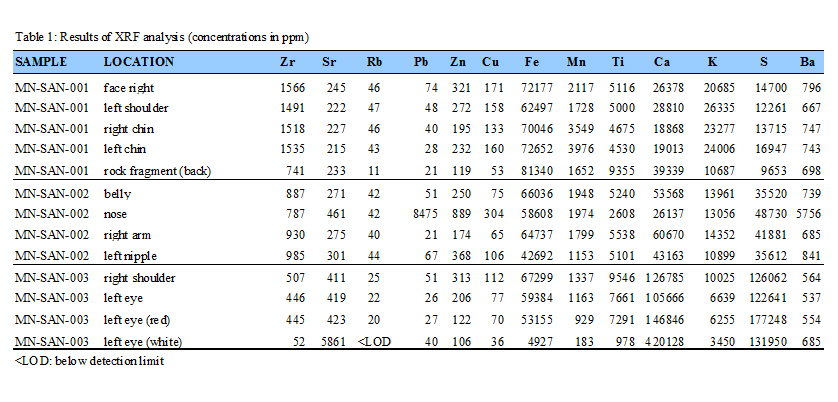Museo Nacional de Historia Natural, Santiago de Chile
Megalithic Stone Sculpture from Easter Island (Rapa Nui) In the collection of the Museo Nacional de Historia Natural, Santiago de Chile
Jo Anne Van Tilburg, Ph.D.
Cristián Arévalo Pakarati
Informal Data Report to Claudio Gomez, Director,
Museo Nacional de Historia Natural
Appendix: Results of the 2012 XRF Analyses
Christian Fischer, Ph.D.
Mónica Bahamondez Prieto
Introduction
This report is generated with the use of data on file in the Easter Island Statue Project (EISP) archives. Data were collected by Jo Anne Van Tilburg and Cristián Arévalo Pakarati on-site during four visits in 1991 and 2007 and as well during various archive searches in Chile. The numbers assigned to each statue are EISP inventory numbers. The actual museum accession numbers are cross-referenced in the EISP files. Publication of the recent British Museum Press volume dealing with that museum’s statues includes a summary description of these in Santiago(Van Tilburg 1992, 2006). Data provided in the Appendix were collected by Christian Fischer and Mónica Bahamondez P. on site in 2012 and as part of the Easter Island Statue Project Conservation Initiative funded by the Archaeological Institute of America.
Provenance and Condition
The history of two basalt moai and one late carving of red-painted stone with associated white-wash or pigment in the collection of the Museo Nacional de HIstoria Natural, Santiago de Chile, is complex. The original Rapa Nui locations of the carvings were not documented as of 2006 (Van Tilburg 1991, 2006). However, we now have the provenance of one of the figures relatively well established. According to a photograph in Easter Island Statue Project (EISP) External Collections and originating in the Captain J.P. Ault, U.S. Navy Collection at the Carnegie Institution, Department of Terrestrial Magnetism, the statue MN-SAN-001 was found some seven miles from Rano Raraku and probably in the vicinity inland from Ahu Vaihu.
The statue MN-SAN-001 was intact when found. According to our research it is highly probable that the statue was sold intact to Captain Ault by a group of Rapa Nuipeople who had sold similar objects to Katherine and William Scoresby Routledge only months earlier. The Carnegie, the vessel under Ault’s command, carried the sculpture to mainlandChile. Museum records do not indicate how, when or in what condition the statue arrived inSantiago, but it is possible that it was broken in transport fromValparaiso. According to the Smithsonian Institution photograph (see below) the statue MN-SAN-003 was also intact when it was displayed in 1919. This is documented by a photograph in the collection of the Smithsonian Institution. It is now also broken. Thus, the condition of these two figures is poor. In addition, the methods taken to restore each to one piece were extremely poor. The fixative used to attach the broken pieces is not the same in both statues. The fixative used on MN-SAN-001 is white and was applied very heavily. The fixative used on MN-SAN-003 is more opaque, dark and somewhat shiny. Both materials were poor choices, their application was insensitive and the results have disfigured both statues.
History and Chronology
The statues are all different one to the other in terms of style and form. They are also all unique, in and of themselves, in that they have or lack very specific features. One (MN-SAN-003) has direct links to woodcarving style and probably use. All are relatively late in time. One of them (MN-SAN-001) was certainly shown deliberately to Captain Ault in the hope of selling it. At least one of them (MN-SAN-003) may have been used in ceremonies connected with mortuary practice. It is unlikely that any of the three were erect upon ceremonial platforms in the classic manner ofRapa Nuimonolithic sculpture.
Material
The stone of which MN-SAN-001 is carved is dark, rough, deeply pitted volcanic rock not from Rano Raraku. Its color and texture are similar to trachyte found on Poike. Without proper testing, however, the stone cannot be properly characterized and is preliminarily coded in the EISP file as basalt The quality of the relatively dark, smooth basalt in Statue MN-SAN-002 compares favorably to Hoa Hakananai’a (BM-LON-001) and the stone may have come from the Rano Kau flow. Statue MN-SAN-003 is carved of what appears to be a red scoriaceous lava, a material “basaltico” that has weathered to a deep red. These comments are all subjective and were made in 1991. For a more recent and objective analysis of the stone please see the Appendix.
Acknowledgements
We are grateful to Museum Director Claudio Gomez P. Museo Nacional de Historia Natural for permission to conduct research on these objects, Leslie Azocar, Director of Collections, Museo Nacional de Historia Natural and to the staff and personnel of the Museo Nacional de Historia Natural for their gracious assistance. Thanks to Sonia Haoa Cardinal, Consejo de Monumentos Nacionales Isla de Pascua. Our appreciation as well to the Archaeological Institute of America, the Consejo de Monumentos Nacionales, and the Consejo de Monumentos Nacionales de Isla de Pascua for their generous support and assistance. Deidre Whitmore and others on staff at the Easter Island Statue Project compiled the data used in this report.
Contact
Jo Anne Van Tilburg, Ph.D.
Director,Easter IslandStatue Project
Director, Rock Art Archive, University of California, Los Angeles
Cristián Arévalo Pakarati
Director,Easter IslandStatue Project
Mana Gallery, Hanga Roa
Christian Fischer, Ph.D.
Material Science and Engineering, UCLA
UCLA/Getty Conservation Program
Mónica Bahamondez Prieto
Directora
Centro Nacional de Conservación y Restauración
Telefono (56-2) 7382010
Claudio Gómez
Director Museo Nacional De Historia Natural
Dirección de Bibliotecas, Archivos y Museos
Teléfono +56 (2) 680 4623 – 680 4621
www.mnhn.cl www.dibam.cl
Leslie Azocar
Jefa de Colecciones Museo Nacional De Historia Natural
Direción de Bibliotecas, Archivos y Museos
Teléfono (56-2) 6804643
www.dibam.cl
Metadata Reports
The following reports are attached to the images in the EISP Archives presented here as figures. Other and additional images are available.
Object: MN-SAN-001
Report metadata 1
Primary author: Van Tilburg, Jo Anne 2007
Source: Easter Island Statue Project Archives
A photograph in the Captain J.P. Ault, United States Navy Collection of the Carnegie Institution, Department of Terrestrial Magnetism, Washington, D.C.clearly records this statue standing upright, supported by large rocks (Van Tilburg 2010). The caption notes “moved 7 miles” from Rano Raraku. This may mean that the statue was found in the vicinity of Vaihu, although the photograph does not confirm that beyond doubt. It did not originate in Rano Raraku as the caption suggests as it is not carved of consolidated lapilli tuff, The statue was intact when found but, according to the records available in the Museo Nacional in Quinta Normal, arrived broken at the Museo Historico where it was repaired in the extremely poor manner in which it was seen in 1991 (Figure 1). Because none of the available museum records name the vessel on which the statue was transported, it is probable that it was not an official Chilean ship and may have been carried to the mainland by the “Carnegie.”
Report metadata 2
Primary author: Arévalo Pakarati, Cristián 1991
Transcriber: Van Tilburg, Jo Anne
Source: Easter Island Statue Project Archives
This statue was first listed in the inventory of the Museo Historico Nacional,Santiago. Its number there was 4578. Sometime in 1985 it was moved to the Museo Nacional de Historia Natural in Quinta Normal. We do not have a record of an inventory number for that museum so, as a consequence, will use 4578. See drawings (Figure 2) and Corr file for more detailed information on the documentation process. See also JVT field book for sketch with metrics.
Report metadata 3
Primary author: Van Tilburg, Jo Anne 1991
Source: Easter Island Statue Project Archives
This object is an Easter Island statue standing in the midst of a natural history exhibit in the Museo Nacional de Historia Natural in Quinta Normal at a location that is not the same we originally saw it in 1991 (Figure 3). It is supported by a circular, footed iron and rebar stand.
The stone is very dark, rough, deeply pitted volcanic rock not from Rano Raraku. Its color and texture are similar to trachyte found on Poike. Without proper testing, the stone cannot be properly characterized and is coded here as basalt. It is not good quality sculpting material. The base is badly broken or perhaps it was never completed. The statue is broken tranasversely across the face and has been repaired with what appears to be cement (an unfortunate choice of material as it is very disfiguring). It is also broken on the upper right side of the head. The chin is broken. It actually appears as though the statue was dropped, perhaps when off-loading it from the ship on which it arrived to the mainland. There is no chin tattoo. The eye sockets are carved. The hands and hami are barely visible. The chin may have had a Y-shaped tattoo. The clavicle is marked, and there are designs on the neck. The back is pockmarked. There is a single circle dorsal design of the “ring and girdle” type.
It has a rounded and bulging stomach. The ears are very roughly carved, the nose is somewhat flat, and the mouth is somewhat open. This latter feature is distinctive and can be compared to the basalt statue on the site known as Te Pepe Renga (PSE 84; 33-298-001). The statue has an overall presentation very similar to the boulder carving 01-206-001 and can be directly compared to it, suggesting that the latter is a statue in process or that, alternatively, it was modeled after MN-SAN-001. It is also somewhat similar in the tilt of the head to BM-LON-002.
Object: MN-SAN-002
Report metadata 1
Primary author: Van Tilburg, Jo Anne 2007
Source: Easter Island Statue Project Archives
This statue was re-photographed in 2007 where it is currently standing in an upstairs gallery in the Museo Nacional de Historia Natural, in Quinta Normal (Figures 4, 5). During our March, 2007, visit to the museum, there was a conference going on in the gallery and the time and light available were minimal. However, it is very clear that this statue relates to at least three others in the EISP database in the unconventional manner in which the hands and fingers are carved. Statues with hands and fingers treated in an unusual way include the Rano Raraku tuff statues on site 29-001; the basalt moai called Te Pepe Renga at site 33-394-001, and a statue in transport on the exterior of Rano Raraku (RR-002-149). Other statues with unusual or elaborated hands and fingers include many of those at the reconstructed site of Ahu Tongariki; 05-297-001; MR-BRU-001; PR-OXF-001, 02-209-009, and MN-SAN-003. The quality of carving in this statue, the forms and features and even the quality of the basalt compare favorably to Hoa Hakananai’a (BM-LON-001). It should be noted that this statue has several characteristics in common with both Moai Hava and Hoa Hakananai’a. These include the marked clavicle; the general proportions; the tilt of the head. The slightly jutting-out position of the arms from shoulder to elbow create a flat surface on the back upon which it would have been possible to superimpose petroglyphs. This carving may be unfinished.
Report metadata 2
Primary author: Arévalo Pakarati, Cristián 2004
Transcriber: Van Tilburg, Jo Anne
Source: Easter Island Statue Project Archives
This statue was first in the inventory of the Museo Historico Nacional, Santiago. Its number there is 4579 (Figure 6). Sometime in 1985 it was moved to the Museo Nacional de Historia Natural in Quinta Normal. Its inventory number there is 3028. Therefore, the Museum cross-reference we assign it is 4579/3028.
NOTES (CAP):
Descripcion: Moai Basalto oscuro muy poroso, piedra local costerfa.
Solo contiene 3 dedos y el hami muy indefinido no se nota.
En su contextural general se parece al Hoa Haka Nana Ia.
Con signos en la espalda.
Pequenas caracter en el cuello.
Basalto ocsuro y poroso
La alturadel cuerpo converta con la longitud de la cabeza. Basica bajo y ancho.
NOTE on measurements (JVT):
The hami is 8 cm wide.
The fingres are 24 cm long
Each finger is 4 cm wide
The measurement between the nipples I 38
Each eye is 13 x 10 cm
The septum is 9 cm
The arms jut out 3 cm from the back on both sides, and the back is very flat. The shoulder and spine detail are present.
The ring on the dorsal design is bas-relief. The arched lines across the back are 48 cm long. The clavicle is marked. There are faint lines on the neck.
Object: MN-SAN-003
Report metadata 2
Primary author: Van Tilburg, Jo Anne 2007
Source: Easter Island Statue Project Archives
This statue was photographed and examined briefly in March, 2007, where it was on display in a gallery temporarily closed to the public (Figure 7). The earlier observations by CAP are valid, and the red and white paint is still evident (Figure 8). The presence of paint links this statue to Makemake carvings and to woodcarvings, as well as to statues carved of red scoria.
It is clear from a photograph in the collection of the Smithsonian Institution that the statue was intact in 1911, when it was photographed on display in what appears to be a gallery of the same museum in which it is now found. A key design detail is the hands, which relate in position to several others in the database. Further, it is clear that the statue does not have a hami. The hands, which are somewhat higher on the torso than would be the norm, are positioned in such a way that they recall 02-209-009 and 14-548-R20. All three statues appear to be displaying a vulva in the manner of some late woodcarving (see carving collected by “Boy Austin,” HMS “Topaze,” 1868; Van Tilburg 2006). Both the wood and stone carvings in question, including those of megalithic proportions such as MN-SAN-003 are probably late in time. The earliest might be 14-548-R20, which has no specific published provenance but may have been part of the pre-tsunami ahu fill (see Vargas et al. 2006 for a description of the reconstruction of Ahu Tongariki that does not include the original position on the site of 14-548-R20 or other fragments in the EISP database).
Other important portable and monolithic statues with unusual hand/hami details include: PR-OXF-001; MR-BRU-001; 33-294-001; 05-297-001; RR-002-149; RR-001-177;29-001-001and 002, and MN-SAN-002.
Report metadata 2
Primary author: Arévalo Pakarati, Cristián 1991
Transcriber: Van Tilburg, Jo Anne
Source: Easter Island Statue Project Archives
This unusual statue, broken across the lower mid-torso and then very poorly repaired,, is carved of a red scoriaceous lava, a material “basaltico” that has weathered to a deep red. In addition, the entire surface of the statue is covered in red kie’a or paint, including in the eyes. It was also, according to EISP archive photographs, once painted with a white material. The treatment of this statue is thus quite unusual, and recalls the treatment of woodcarvings in which the eyes and nostrils are painted with kie’a. This appears to be a late statue that, in some ways, mimics both the moai of Rano Raraku and the Makemake carvings.
The stone is similar to that locally available along the coast and on Poike.
References Cited
Van Tilburg, Jo Anne, 1992. “HMS Topaze on Easter Island: Hoa Hakananai’a and five other museum sculptures in archaeological context.” London: British Museum Press Occasional Paper 73.
Van Tilburg, Jo Anne, 2006. Remote Possibilities: Hoa Hakananai’a and HSM Topaze on Easter Island. Research Paper 158.London:BritishMuseum Press.
Van Tilburg, Jo Anne, 2010. The Orongo Doorpost. Paper presented at the Easter Island Foundation Conference,Gotland,Sweden.
Appendix: Results of the 2012 XRF analyses on three statues in the collection of the Museo Nacional de Historia Natural (Santiago de Chile)
The analysis of the three statues was done with a Niton XL3t GOLDD portable XRF and the data were acquired during 90s in soil mode. Because of the surface heterogeneity, the visible pronounced weathering and traces of pigments, the data given in Table 1 should be considered as ‘semi-quantitative’ and cannot directly be compared with published data on the composition of volcanic rocks from Easter island. However, the concentration levels obtained for some elements such as zirconium (Zr), strontium (Sr), rubidium (Rb), titanium (Ti) and potassium (K) provide some guidelines and have been used for the identification of the rock types.
1. Statue MN-SAN-001
The high concentrations in Zr (~ 1500 ppm) and K (~2.4 %) found for this statue indicate that the rock is most probably a trachyte. The relatively high sulfur (S) content (> 1%), probably in the form of gypsum (hydrated calcium sulphate), is a clear indicator of weathering (though it could have been applied as a ground/pigment) which could also explain the relatively high and variable values obtained for manganese (Mn). The analysis of a rock fragment embedded in the trachyte on the back of the statue indicates a composition close to a mugearite/ benmoreite rock type.
2. Statue MN-SAN-002
The composition of the stone shows lower concentrations of Zr (~ 900 ppm) and lower K (~ 1.3%) which indicates that the rock type is most probably a benmoreite. The measurement on the nose has detected significant concentrations of lead (Pb), barium (Ba) and zinc (Zn). Although the color of the nose is very dark (could be due to the alteration of Pb), the association of lead and barium and traces of zinc, as well as the very high levels of sulfur, points to a white pigment known as Flemish white which was manufactured in Flanders during the 19th century. However, for the other measurements, the sulfur concentration is also high and could be explained by the presence of gypsum; an interpretation consistent with the numerous small white spots visible in the crevices on the surface of the statue.
3. Statue MN-SAN-003
The general aspect of statue MN-SAN-003 is very different from the two previous ones and shows visible traces of white and red paint. Although slightly different, the stone looks similar to the tuff of Rano Raraku (fine-grained type) which has an average elemental composition close to a mugearite. For the statue, the concentration range of elements such as Zr, Ti and K is consistent with this composition. The white paint is composed of gypsum while the red pigment is most likely red ochre.
 English
English  Español
Español 